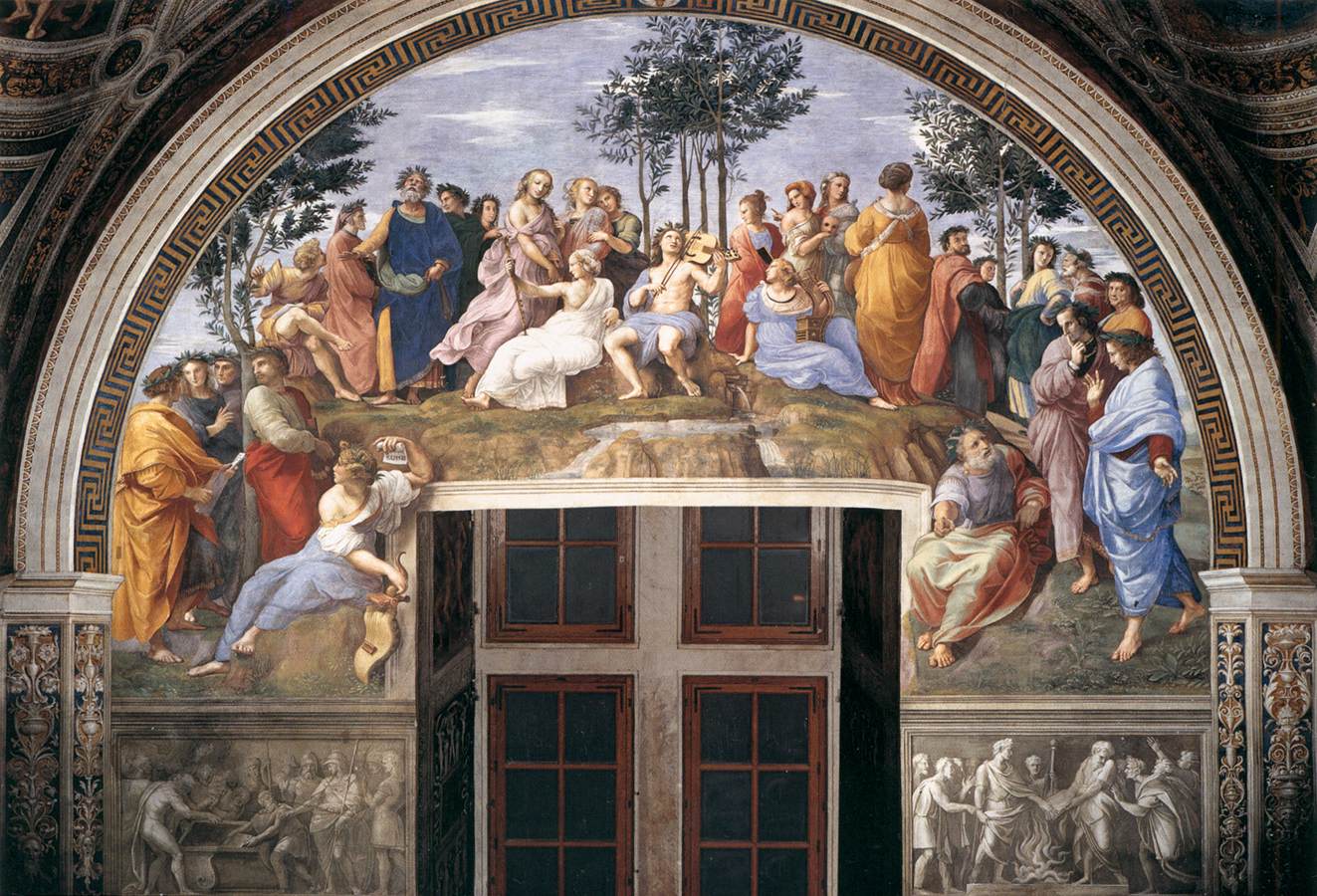The Parnassus
Story
The third composition for the Stanza della Segnatura represents Parnassus, the dwelling place of Apollo and the Muses and the home of poetry, according to classical myth.
Mount Parnassus, the home of Apollo, is, like the hill of the Vatican, a place where in ancient times there was a shrine to Apollo dedicated to the arts. This has a direct bearing on the picture because through the window on the wall where the fresco is painted there is a view of the Cortile del Belvedere and the hill of the Vatican. There were newly discovered classical sculptures in the Cortile, such as the Ariadne that Raphael used as a model for the muse to the left of Apollo.
Apollo plays a lira da braccio (an anachronism which, according to some, was meant to symbolize the perpetual value of the poetic message). He sits under a laurel grove with the nine Muses (who personify the nine types of art). The most eminent classical and contemporary poets are depicted together in a harmonic ascending and descending movement from left to right. Homer is flanked by Virgil and Dante, Ovid and Horace are next to Sappho, while from the "ranks" of moderns we can identify Petrarch, Boccaccio and Ariosto. Petrarch is recognizable in the group in the left foreground; so is Sappho, who holds a scroll bearing her name; Ennius is seated above them, listening to the song of the blind Homer (who appears as a protagonist, like Apollo), behind him stands Dante, who had also appeared in the Disputa as a theologist, evidently because of the doctrinal content of the Divine Comedy. Some see the portrait of Michelangelo in the bearded figure immediately to the right of the central group, although it is more readily identified with Tebaldeo or Castiglione, for the scene is, after all, a celebration of poetry.
Raphael in several sketches significantly changed some of the details, including the musical instruments used. In the early versions Apollo played on a traditional stylized classical lyre, but this fresco shows him playing a Renaissance lira da braccio with a bow. The bow was unknown in Antiquity, although later they attributed its invention to Sappho. It has nine, instead of seven, strings to match the number of Muses; this, in Raphael's conception, signifies timelessness, just as the fact that the classical and contemporary poets are depicted together.
While working on this fresco, the artist may have become acquainted with that ancient sarcophagus from Asia Minor which is adorned with the relief sculpture of the nine Muses. This was his source for the three additional instruments shown in this fresco: Erato's kithara, to the right of Apollo, the Lydian aulos of Eutherpe, on the other side, and below, the strange, tortoise-shell lyre of Sappho - all of which he rendered striving for archeological accuracy.
In this fresco, music fills the role of moving force behind the Apollonian universe, at the same time being the symbol of poetry.
Compositional harmony and visual counterpoint characterize the fresco: the groups of figures are bound together by continuous lines and the single characters are represented in opposed but corresponding poses. Although the Parnassus lacks the high originality of the School of Athens, it demonstrates Raphael's illustrative ability. It is enriched by classical elements which must have held great appeal for a cultural class excited by the recent archaeological discoveries. Thus we must add Raphael's capacity to interpret contemporary taste to his genuine artistic skills.
